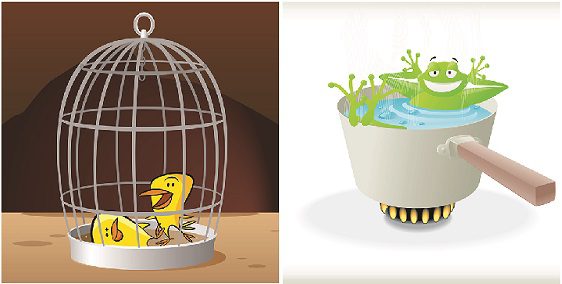A Second on Safety with David G Broadbent
When I first started my working life as a Metallurgist at the BHP (Newcastle, NSW, Australia) Steelworks in 1980, one of the first departments I was assigned to was the Blast Furnace. This was a high risk work area and people had been known to lose their lives working within Blast Furnace environments.
In those days one of the occupational classifications at the Steelworks was that of a Gas Watcher. Now the Gas Watcher was really just someone who carried around a cage – and occasionally cleaned it. What was important was what was inside that cage. Inside was a yellow canary. Really the key task of the Gas Watcher was to watch the canary. If that bird ever fell of the perch then emergency evacuations were put in place.
Now one of my tasks each morning was to take a walk to the Stove Cabin (control room) of each Blast Furnace (we had four) and collect the monitoring records of the previous evening. In each Stove Cabin, just to the left of the door, was a cage with a little yellow canary. These particular birds did not have a “watcher” assigned to them. They just lived in that Stove Cabin and received a visiting service to top up their seed and clean out their little cage. Not bad service really.
Anyway, one morning (between Christmas and New Year 1980) I was walking into the Stove Cabin with the shift foreman. As I went to enter doorway the foreman came barrelling out past me, almost knocking me over in his haste to depart. As the foreman was streaking past I was able to make out words to the effect of “clear off – the bird!”. I immediately modelled my behaviour on my far more experienced colleague – I ran for it.
You have probably guessed that the little canary was laying feet up in the bottom of the cage. It was a long maintained habit that whenever you walked into a Stove Cabin you took a peek to the left and checked out the canary. On this particular day, the poor thing had died.
So why use a canary?
It just so happens that throughout the 19th and early 20th centuries, coal miners would take canaries down to the tunnels with them as an early detection system against life threatening gases such as carbon dioxide, carbon monoxide and methane. The canary, normally a very songful bird, would stop singing and eventually die if not removed from the presence of these gases, signalling the miners to exit the mine quickly. So, as recently as the early 1980’s Australia’s leading steel producer was still using the canary as a key element of their toxic gas detection program.
In short the canary was an early warning system. It was able to detect potentially harmful situations prior to these becoming a problem for the human workforce. So, how many canaries do you want in your workplace?
Now there just happens to be another workplace animal that can become quite common in workplaces.
This one is the Frog.
How often have you heard the story that if you place a frog in tepid water and slowly bring that water up to the boil, that the frog shall happily swim about until it too has been boiled to death. The essence of the story is that if you are in a comfortable non-toxic environment (read workplace) and that environment changes in infinitesimal increments, there is a very
good chance that you may well not notice. For many of us this is a pretty accurate description of how we function. If we were to use safety language we might refer to this type of situation as the development of Risk Tolerance. Allow me to suggest that Risk Tolerance is in itself a toxic process.
We see the same sort of frog like thinking happening all the time in our workplaces . I have lost count as to the number of Transformational Safety Culture Walkabouts I have conducted and mentioned a potentially hazardous observation to my Host. In at least two thirds of such situations the response has been one of “didn’t know” or “didn’t see”. Some of these have been quite significant e.g., uncovered/unlabelled confined spaces, working at heights using visibly frayed/cut fall protection equipment, and others.
Another common experience I have is what I call “defending the frog”. When we conduct quantitative Safety Culture Reviews one of the common responses is one of “denial”. I hear stuff like “that can’t be right, we would have seen it/felt it etc”. You have just found out that over half of your workforce acknowledge multiple shortcuts when performing their work, and the autonomic response is “can’t be happening”.
Toxic frog like thinking.
So we come back to the question. Do you want canaries or frogs inside your workplace. Allow me to answer the question for you. It is actually what we call a “no-brainer”. The answer must be the Canary. Forewarned can be forearmed, and the canary is essentially an early warning system. To take this metaphor that little bit further, you need to be sure to let your canaries out of the cage. When you do that they fly about above the workplace and you have a much better chance of getting to see those warning signs.
Worth a thought,
In the meantime, stay safe and well.
David G Broadbent
Safety Psychologist














Add Comment